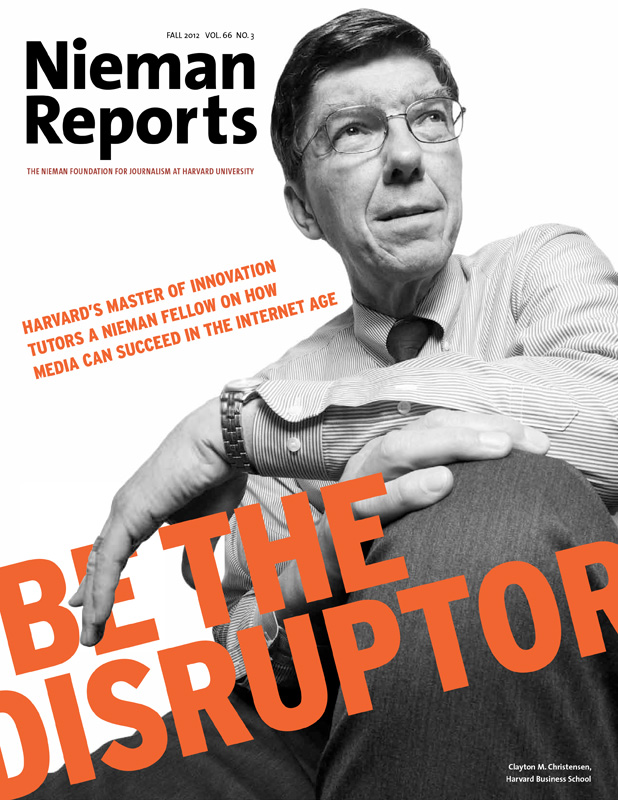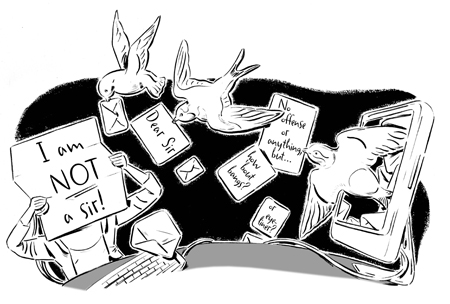
Be the Disruptor
Harvard Business School professor Clayton M. Christensen’s theory of disruptive innovation provides a framework to understand how businesses grow, become successful, and falter as nimble start-ups muscle in on their customers. It’s a familiar story, one that has played out in the steel and auto industries, among others. Now Christensen, in collaboration with 2012 Nieman Fellow David Skok, has applied his analysis to the news industry. Their goal in this issue's cover story, “Breaking News,” is to encourage news executives to apply the lessons of disruption to the media industry as a means of charting new paths to survival and success.

In August 2009, about a year after I began working at The New York Times, the following piece of reader mail popped into my inbox:
READER'S NAME: Darcy
READER'S MESSAGE:
Hi Kate,
I think highly of you and I wanted to simply suggest something. I think you could be more beautiful with a different haircut and just a tad bit of eyeliner and mascara. Please don't get upset, I haven't the slightest idea how to write this, but I think you could dazzle with just a little effort. I was thinking bangs and perhaps a shorter cut? Anyway, you're welcome to toss this, but I've done lots of make overs and think just 5 mins in the morning would do the dazzle thing. Sorry if I've offended—totally not intended.
Aren't readers the best? Just when you are having a lousy or boring day, something weird comes along to keep you entertained.
I showed Darcy's e-mail around the Times newsroom, and my colleagues collapsed in laughter. There was instant speculation—was Darcy a man or a woman? Would I take him/her up on it? What about bangs, anyway? As to what I should write back, someone suggested, "Dear Darcy, I bet Frank Rich could use a makeover, too."
Readers' imaginations know no bounds, and with the Internet, they're just a click away from sharing it. Darcy's note shot right to the top of my strangest-comments-from-readers list. But just having my photograph up on the Times website triggered a message roughly every few months from someone who felt free to remark on my resemblance to this or that Galbraith. Another piece of reader mail opened with: "Kate, are you a Dunlap? While reading nyt.com yesterday I saw your name, and then your photo. I sent your photo to my sister Sarah, and she thinks you look like a Dunlap, too." (Astonished, I forwarded the note to my mother, whose maiden name was in fact Dunlap, and she confirmed that the writer had attended her wedding reception.)
In my current work at The Texas Tribune, I keep a special folder in my inbox. It's called "Weird Stuff." Mostly, the e-mails in it are from public relations people peddling concepts like "motorized window treatments." The National Audubon Society made the cut, with a press release entitled "Audubon releases virtual birds all over the Internet." The folder also contains an e-mail from a copy editor—not at The Texas Tribune, to be sure—who asked if he could add a middle initial to the name of one of the people I quoted in a draft article. (Sure, be my guest.)
Other e-mails are from readers. One wrote, "I love the sound of your voice on the radio." Whatever. I have one from someone who addressed me as Karen and wanted me to answer questions for his student paper. I told him I was happy to help but that he needed to correct that and other spelling mistakes before asking for my time. And there are phone messages, too. One person, upon seeing that my mini-biography on The Texas Tribune website included a degree from the London School of Economics, rambled on about Queen Boudicca's destruction of Londinium (London) in the year 60 A.D.
All of this is a far cry from when I worked at The Economist a decade ago. There, because the articles are unsigned, I'd count myself lucky to get a letter every month or so. Almost always it would begin "Dear Sir." "I AM NOT A SIR!" I have screamed silently many a time, in mock frustration. (That's how The Economist prints reader letters, of course.)
A small minority of the reader feedback, of course, is awful—personal and hateful. Some people who write about hot-button issues are probably exposed to this every day. I had just a little taste during my year and a half at the Times. I wrote a post for the "Green Inc." blog (now simply called Green) about a study by statisticians at Oregon State University that attempted to quantify the carbon footprint of having children.
All I did was report the story. You can imagine what happened: The messenger was shot. One e-mail, which I quickly deleted so I can't quote it directly, told me I should be retroactively aborted for writing such garbage. (Much later I unthinkingly told this anecdote to my mother, who blanched.)
Most reader mail, however, is far more benign—like Darcy's. I never actually replied to him/her; I kept intending to, perhaps with the Frank Rich line, but the days slipped away in the usual blur of work and it just never happened. My photo came off the Times website after I got laid off, and I'm happy to report that my Texas Tribune photo has drawn only one comment—a mild compliment from my sister.
And I still don't have bangs.
 Kate Galbraith, a 2008 Nieman Fellow, reports on energy and the environment for The Texas Tribune.
Kate Galbraith, a 2008 Nieman Fellow, reports on energy and the environment for The Texas Tribune.


